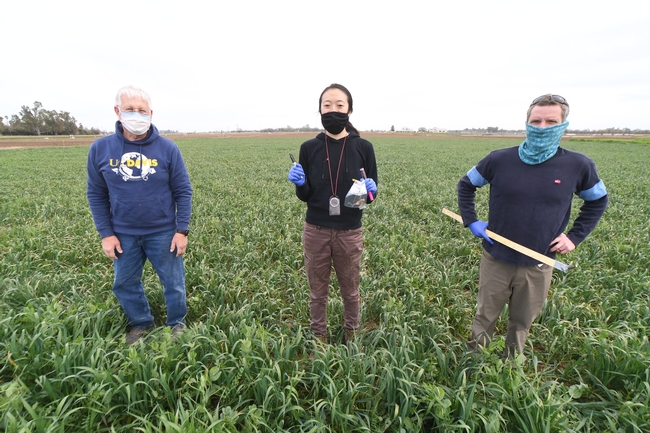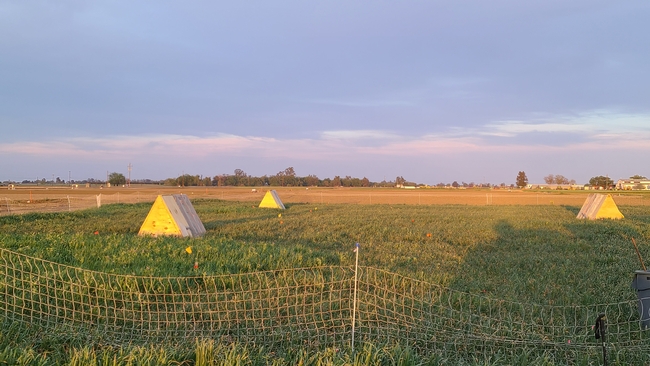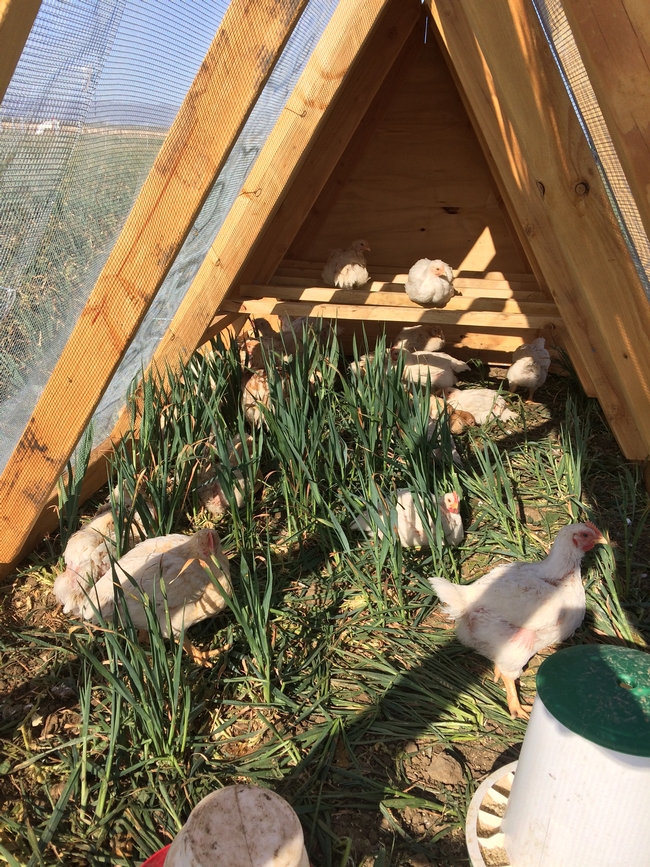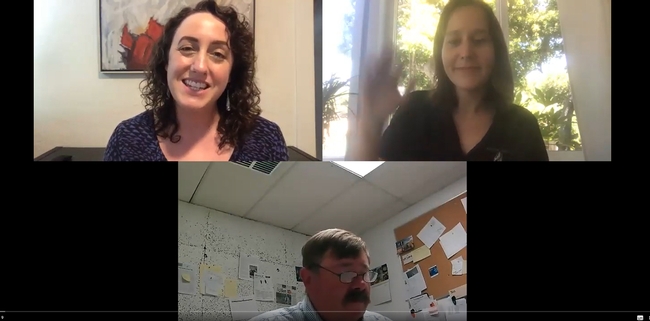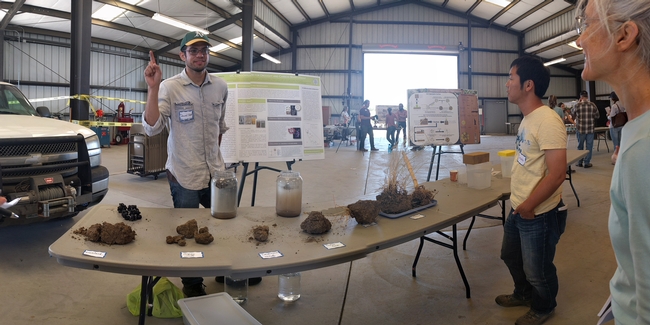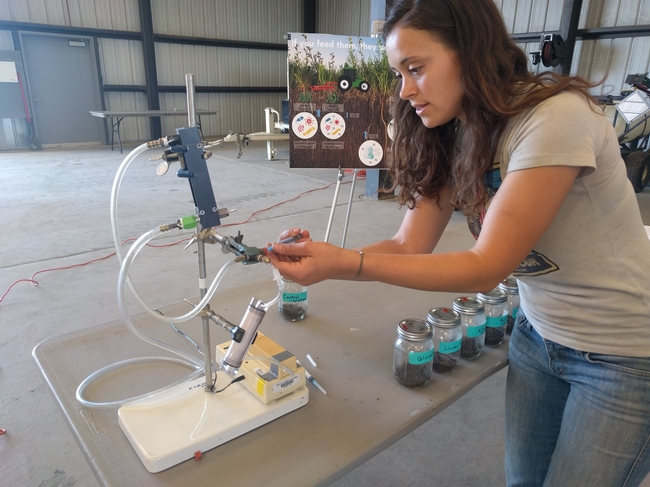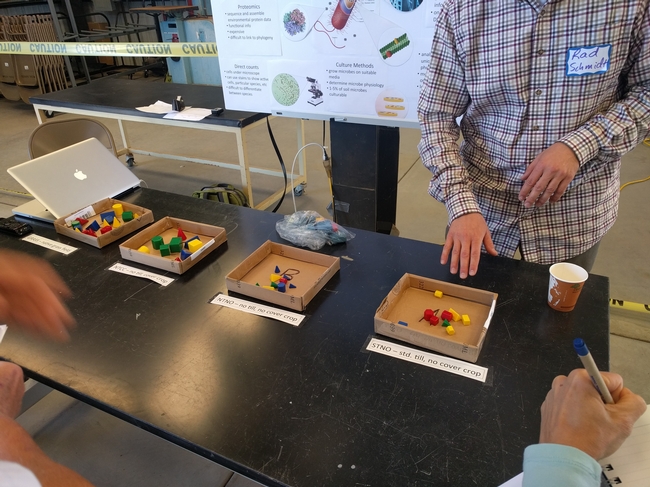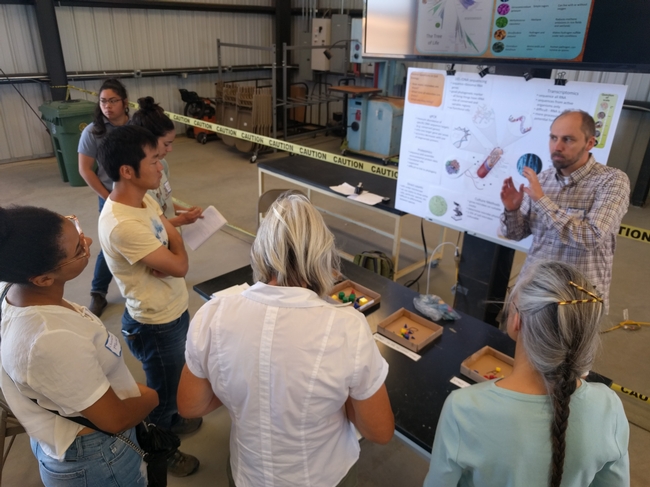Posts Tagged: soil health
Can Calcium Fertilizers Improve Soil Health or Crop Production in Alfalfa?
DIAGNOSING A FIELD PROBLEM Can applications of Calcium (Ca) fertilizers improve plant nutrient uptake or improve soil properties in alfalfa...
Scientists to see whether chickens boost soil health, increase profits on organic vegetable farms
Historically, chickens were not a rare sight on farms, where they contributed to soil fertility as they freely pecked and scratched around vegetable gardens and crop land. Now, UC Cooperative Extension specialists have launched a research project to quantify the potential for chickens to be part of safe and sustainable commercial organic vegetable production.
“It's not a new idea. A lot of farmers are trying this kind of thing,” said UC Davis International Agriculture and Development graduate student Faye Duan, the project coordinator. “But there is currently little scientific information for using chickens on a bigger scale, especially in terms of food safety concerns.”
The California trial is part of a national effort to diversify organic vegetable farms with chickens. Last year, the USDA-funded study was launched by Iowa State University horticulture professor Ajay Nair. The project also includes UC Cooperative Extension specialists Maurice Pitesky and Jeff Mitchell, based at UC Davis, and University of Kentucky entomology professor David Gonthier.
In the trials, chickens are introduced as part of a rotation that includes cover crops and a variety of vegetable crops. In California, chickens were placed on research plots in April following a winter cover crop of vetch, peas, fava beans and oat grass.
“We don't let the chickens run around the field,” Duan said. “We keep them inside of chicken tractors to protect them from predators.”
Twenty-nine birds live in each 50-square-foot tractor, essentially a floorless chicken coop on wheels. The tractors, built by UC Davis students Mallory Phillips and Trevor Krivens, are wood frames covered with mesh and plywood. Each day, the tractors are moved to a different part of the plot, where the birds can graze on cover crop residue and deposit manure. Adjusting to the daily move took time, Duan said.
“The first day, the chickens were confused. We had to go slowly. It's a learning process for the chickens and us,” she said. “But now, the chickens are excited to move to a new spot where they have fresh food to graze on.”
After 24 days on pasture, the chickens will be removed, and become part of the project's meat study.
“We have broiler chickens that are raised for meat,” Duan said. “Some people believe chickens that graze and eat grass taste better and are more nutritious. It will be part of the study to look at the chicken's meat quality.”
Once the chickens have done their part on the research plots, vegetables are planted amid the leftover cover crop residue and chicken manure. This summer, the experiment in California will grow processing tomatoes. Subsequently, melons, eggplant, spinach and broccoli will be part of the vegetable rotation in California or the other states involved in the project. Other replications of the trial will have the chickens immediately follow the vegetable harvest so they can graze on the crop leftovers before the cover crop is planted. Comparing the soil health, fertilizer needs, chicken quality and other factors will help the scientists optimize the rotation.
“Vegetable yield will be an important indicator of success,” Duan said.
Soil samples will be tested to determine the presence or absence of Salmonella bacteria after the chickens have been removed, said Pitesky, a poultry specialist and a project lead. Salmonella is a bacterium that can be part of poultry's microbiome. If the bacteria contaminates human food, it can cause illness.
“Since Salmonella lives in the chicken gastrointestinal system, when it gets into the soil, it will eventually be out-competed by bacteria more adapted to soil than the gut of a chicken,” Pitesky said. “There are many different types of Salmonella, and only a select few found in birds are the ones that are harmful to humans. Nevertheless, it is very important to test and use various practices to mitigate the presence of Salmonella on land that will be used for crop production following poultry.”
Early results of soil tests in Iowa and Kentucky detected Salmonella in the soil where chickens grazed, however, the bacteria disappeared very quickly.
UC Cooperative Extension and Colusa RCD launch 'Soil Health Connection'
University of California Cooperative Extension and the Colusa County Resource Conservation District announce the launch of the Soil Health Connection, an informative outreach YouTube channel. The channel hosts virtual discussions and interviews with leading soil science researchers and farmers with the intention of shedding light on the importance of soil health in California's agricultural systems.
Hosts Sarah Light, UCCE agronomy advisor, and Liz Harper, Colusa County RCD executive director, bring their own knowledge and expertise to the channel by inviting guests and viewers to think about soil health through various lenses. The channel has already released episodes touching on the connections between soils and economics, agroecology, nutrient management, conservation, regenerative agriculture and more.
Featured guests from a multitude of backgrounds help capture differing perspectives and the interdisciplinary nature of the field of soil health. One episode in Spanish has been released.
Soil Health Connection is a product of Light and Harper's collaborative research supported by the California Department of Food and Agriculture Healthy Soils Program in partnership with Richter AG and Davis Ranch. The project is evaluating how soil moisture dynamics change with and without cover crops in an annual cropping system. In addition to the applied research and demonstration aspect, the project also aims to provide a platform for community outreach and education.
Experts in soil health and related fields, as well as growers participating in soil health practices, are encouraged to email Light at selight@ucanr.edu if interested in participating in the Soil Health Connection.
To learn more about soil health in the Sacramento Valley, tune in to hear from the professionals who are getting their hands dirty with these issues every day. New episodes are released bi-weekly at https://www.youtube.com/channel/UCRI4lXL4f_ro_Flnp4lu6IA.
Powers of microbes: UC Davis graduate students get creative to teach farmers about soil microbiology
If you grew up in the 1980s or 1990s (or were a child at heart during that era), the famous Powers of Ten film likely left an indelible mark in your mind.
The film starts with a couple lounging on a picnic blanket and zooms out to the outer reaches of the universe, then back in to peer into the microscopic world of the human body: from white blood cells to DNA, and finally down to the proton of a carbon atom.
In its short 9-minute run time, Powers of Ten manages to inflame an existential angst about the size of a single human life while at the same time connecting the viewer to the beauty of the universe and the human body.
As a high school student watching the video, it filled me with the same sense of awe that I felt the first time I heard Carl Sagan's famous quote that “we are all made of star stuff.”
Powers of Ten reminds us that looking at the world from different perspectives, from the very tiny to the immensely large, helps create a better understanding of the natural world, our place within it, and how we can impact it for good.
Had Powers of Ten returned from outer space by zooming into a piece of soil rather than a the human body, it would have explored the billions of living creatures in one handful of soil, slowly scaling down from millipedes to earthworms to ants to nematodes to protozoa, and finally down to the soil's bacteria and fungi that make up the base of the soil food web.
The video might then have looked a lot like the recent workshop at the Russell Ranch Sustainable Agriculture Facility, which served as a science fair for farmers and researchers to learn about the minuscule but powerful soil microbe.
While farmers often have a baseline knowledge about soil microbiology and its importance on the farm, “the science is evolving so quickly at this point, that it can be hard to keep up,” said attendee Margaret Lloyd, UC Cooperative Extension advisor who works with small-scale farmers in Yolo and Sacramento counties.
The workshop coupled foundational principles of soil microbiology with practical on-farm management situations, making the case for farmers to actively consider soil bacteria, fungi, and other micro organisms in their decision-making process.
Jessica Chiartas, a fourth-year graduate student in soil microbiology and one of the workshop organizers, is somewhat of a soil science evangelist.
Her hope was to help workshop attendees better understand that “soils are not just physical, chemical systems. A majority of the processes that take place underfoot are biologically driven. Soils are living and breathing bodies and much like us, they need to be fed, covered, and protected from disturbance” in order to function in the long term.
Scaling down
The scale of microbial activity in soil makes it challenging to help farmers dig into just what scientists are talking about when they talk about microbes.
“It's important to talk about the scale of microbes,” Chiartas said. “So much of what goes on in soils is mediated by microbes and the scale that they operate on is far different than the scale we measure them at. Our typical method of soil sampling and analysis is analogous to harvesting whole fields of crops, chopping them up, throwing them in a heap and then trying to glean information about the individual plants.”
The presenters at the soil health workshop used vivid analogies to translate the abstract results of scientific research and hard-to-imagine scales into concrete, relatable concepts.
A single gram of soil may contain a billion bacteria, and several miles of fungal hyphae, the web-like growth of fungus. Translated into human scale, the numbers are mind boggling.
If a single microbe were a 6-foot-tall person, then a single millimeter of soil would be as tall as the empire state building. A typical soil bacterium contains as many DNA letters in its chromosome as two copies of “War and Peace.” A stack of copies of “War and Peace” equivalent to bacterial DNA from a single teaspoon of soil would be larger than the Great Pyramid of Giza.
A soil information revolution
The metaphors of scale are a fun thought experiment, and they could provide a jumping-off point for a discussion between farmers and scientists essential for improving our current understanding of soil as a living system. Climate change is expected to amplify the effects of soil erosion, compaction, nutrient leaching and other issues common in our current agricultural systems.
“We need improved management that works with the soil ecosystem to increase crop production while enhancing soil health,” said Radomir Schmidt, a postdoctoral researcher and workshop organizer. ”That's going to take a concerted effort and open dialog between farmers, scientists, and citizen scientists to discover, test, and implement these methods in the real world.”
We are now in the era of “soil information revolution," Schmidt said. As our knowledge of the soil microbiome expands, implementing this knowledge in agricultural practice is more and more possible.
This graduate student cohort is well-positioned to make the necessary connections, learning from farmers while helping them zoom in to see the essential lifeforms that impact their farm, then zoom out to help make decisions that are good for the farmer, good for the crop, and good for the microbe.
Farmers in the Davis area will have another opportunity to learn soil health fundamentals at a workshop this fall hosted by the UC Sustainable Agriculture Research and Education Program and Russell Ranch Sustainable Agriculture Facility. Details about the workshop will be posted here.
From the field: Slow spring growth and what is (or is not) causing the problem
A consultant recently brought in some alfalfa plants to get another opinion on why growth was resuming slowly this spring. The field is located...


